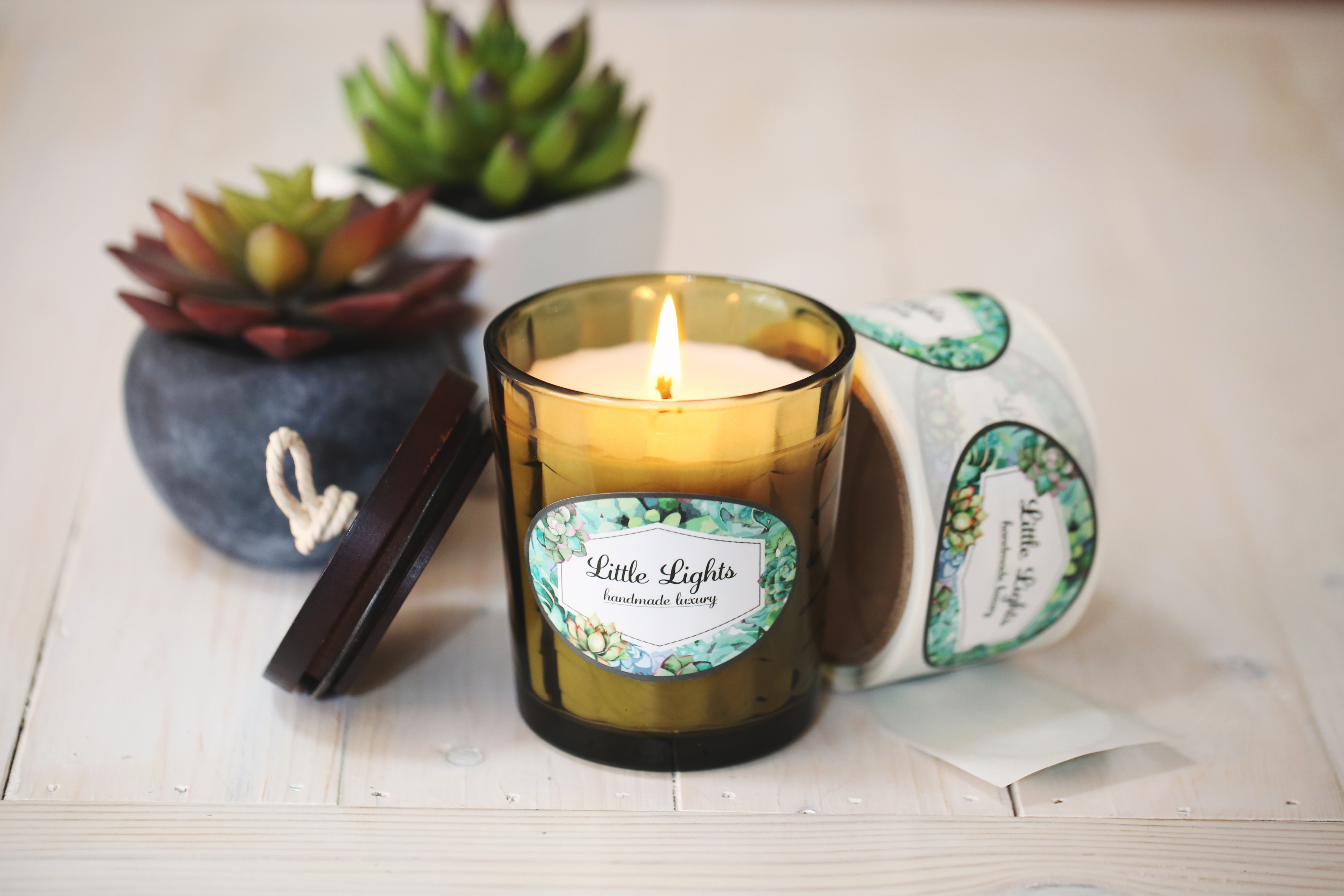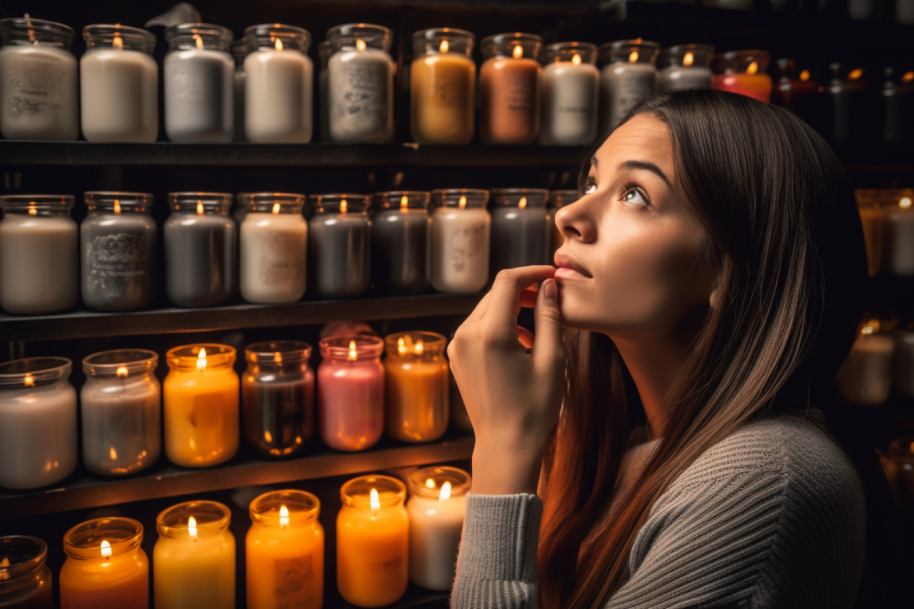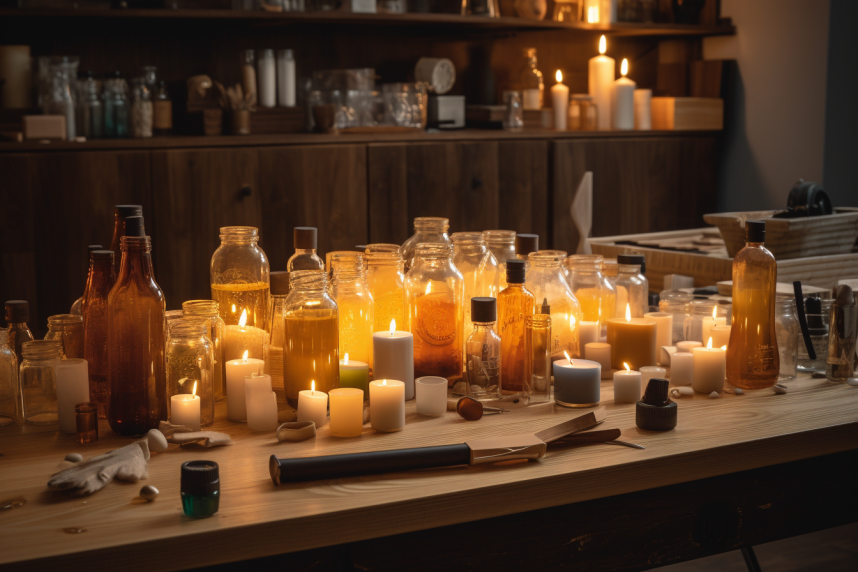How to start a candle business at home: Step-by-step guide
Posted by Alberto Queiroz on
Who could have predicted that candles, of all things, would be increasing in popularity in 2023?
Our age is one of plentiful lighting, as an image of Earth's light pollution map will show you. But not even the uber-cheap and ubiquitous LED lamps that illuminate our interiors managed to snuff out the humble candle from our homes.
No longer relevant for lighting, this 5000-year-old invention found a new purpose in decoration and lifestyle. Modern home décor tendencies and well-being practices such as aromatherapy have fueled the demand for artisanal and scented candles — a tendency compounded by the pandemic-inspired rise of wellness trends among millennials.
With the current $12.88 billion global candle market burning bright and an expected growth rate of 5.7% from 2023 to 2030, the popularity of candles is as far as ever from dying out and the moment is ripe for aspiring chandlers everywhere.
Want to know how to start a candle business at home? Then light yourself a candle and read on as we provide an overview of the main steps for starting a candle business.
1) Choose your niche
Before you get started with your candle business, determine what will your niche be. It's best to start small and do one thing well, keeping the alternative to expand to other candle types later on.
Main types of candles
As candle aficionados know, candles come in diverse shapes, sizes, aromas, and materials. Let's go over four common types.
Scented candles
Scented candles are a great way to relieve stress and create a relaxing environment. Alongside essential oils, they make up the core of aromatherapy and have also grown in popularity as we spend more time at home and are more concerned with how our dwelling spaces smell.
Research has even shown the right smells can increase our productivity. All of this makes aromatic candles a great candle-making niche.
Decorative candles
All candles are extremely versatile when it comes to decoration, but you can choose to make candles targeting a special kind of décor or style. Decorative candles such as the ones used in hygge trends tend to be odorless, as they're meant to be just a small part of your home environment.
If you choose to work with decorative candles, you'll find it a perfect opportunity to play with shapes and colors. You can even choose to make candles for special seasonal events, such as orange pumpkin-shaped candles for Halloween or green pine-shaped ones for Christmas.
Beeswax candles
Beeswax candles make up a special — and expensive — niche in the world of chandlers. The high melting point of beeswax means these candles will burn longer than regular paraffin ones, but that is far from their only advantage. Beeswax candles release less soot and emit more light, while not having a strong scent, which makes them perfect for a cozy and relaxed atmosphere.
Beeswax is also said to have a positive effect on the quality of the air in your home — as the candle burns, it releases negative ions which neutralize various air pollutants.
The thing to have in mind here is that beeswax is a more expensive material, which may require more careful sourcing and planning.
Soy candles
Soy candles are another in the category of so-called "happy wax" — non-pollutant wax made from natural materials. Because they don't burn petroleum-based paraffin, their flame is cleaner, with a better impact on both your health and the environment. Plus they're sourced from soybeans, which makes them better for the environment.
Similar to beeswax, soy candles also burn longer than paraffin ones. Add that to the fact they're "green" and you have yourself a nice niche for environmentally-conscious customers.
2) Create a Unique Selling Proposition
A Unique Selling Proposition (or UPS, for short) is essentially telling your clients why your product is worth their attention and money — why they should buy from you, and not the competition.
A USP is essential for any business, and for a good reason: Having a good product means nothing if you can't convince your customer to acquire it.
To formulate a compelling USP:
- Identify your target market. Understand what demographic is likely to buy your product. In the case of beeswax candles, that could be middle-class, environmentally-conscious female millennials.
- Determine what makes your product unique. This will be the focal point in your marketing to that audience. Going back to beeswax, it is unique because it is eco-friendly, lasts longer, and is a traditional, timeless product.
- Write a USP that highlights these benefits in a clear and concise way.
- Promote! Your USP can be the focal point of your company's "About" page, your slogan, and even your logo.
3) Develop your product line
A company is only as good as the product it sells. Once you have arrived at your unique selling point, it's time to develop your product line so it matches and exceeds your customers' expectations.
Here, you'll want to experiment with the many scents, colors, and candle styles available, finding high-quality materials for each aspect of your candle line. The combinations here are pretty much infinite, and with enough planning and testing, you'll soon be on your way to crafting your very own brand of candles.
Consider carefully each element of your candles.
Waxes
We already saw how important it is to choose the proper wax for your candle niche. Among the types of candle waxes to consider, we've got:
- Paraffin wax: Also known as mineral wax, it is cheaper, more easily available, and better for strong fragrances. However, it burns faster, releases soot, and is sourced from non-renewable petroleum.
- Soy wax: A perfect environmental-friendly alternative to paraffin wax, albeit less conducive to smells. Burns very well, with little soot.
- Paraffin-soy blend: Blends are often used to bring together the benefits of two materials, as in the case of slow-burning aromatic parasoy blend candles.
- Beeswax: The best-burning type of candle material, it is also one of the most expensive.
- Coconut wax: Another expensive, but eco-friendly alternative that lends itself well to different blends.
Wicks
Wicks can be chosen based on the type of wax or container being used, as well as simply with an eye to aesthetics. The main types of wicks are as follows.
- Flat: The most common type in taper and pillar candles, flat wicks are made up of two or three fiber strands knitted together. They curl into the flame for an effortless self-trimming effect.
- Square: Braided square wicks are often used with beeswax, as they clog less than other types of wicks.
- Cored: Cored wicks are braided around a central piece, usually made of cotton, zinc, or paper, which helps keep them erect. They're popular in jar candles and votives.
- Wooden: Made from wood or combinations of wood fiber and cotton, these wicks have gained in popularity due to their aesthetic effect and the gentle crackling sound they produce.
Fragrances
A powerful, but woefully underused sense, smell is processed differently from any other sense — which is just one of the reasons for the popularity of aromatic candles. Used well, the right scent will help shape unforgettable moments; your scented candles can spark vivid emotions and become connected with precious memories.
Candle fragrances are also a brilliant way to set a mood of relaxation or create an atmosphere for concentration, among many other uses — all of which you should have in mind as you go about choosing, mixing, and inventing your own fragrances.
Don't forget to name your fragrances in original and memorable ways. That can be a nice way to strengthen brand associations, set your product line apart, and explore your creativity.
Containers
The containers you use for your candles should also hinge on your target market and the general style you're going for. Mason or jelly jars have a more rustic appeal, whereas tumbler jars can be directed at a public with more refined tastes. Similarly, the colors you employ should also be in touch with your general branding, candle type, and market.
4) Branding and packaging
Branding is a key aspect of your home candle business — it can be the decisive element that makes customers pick your shop among a multitude of others and keeps them coming back.
While branding doesn't have to take a lot of your time and effort, it does need to be well planned. You want to convey a consistent image and message that will be firmly lodged into buyers' minds, and this means attention to a few key elements.
Designing your logo
Your logo is your brand's calling card. Make it simple or fancy, but make it memorable and in tune with your brand's overall look and feel. If you need help designing your logo, you can check out some of the many templates available in our free Studio design tool.
Making good use of candle labels
Candle labels can be a key branding item that is well worth your time and attention. Besides sharing your logo and brand name with the world, they also help create the general feel you're going for — rustic, refined, modern, or classic.
Choosing the right packaging
Packaging is another often overlooked, but major factor in your overall branding effort. Factors to keep in mind here include:
- Packaging material: Boxes, paper bags, and mailers are just some of the most common options.
- Customization: How do you make your packaging stand out? Among other ideas, custom tags and personalized packaging tape can go a long way toward creating a unique brand look.
- Pricing: An important factor for home businesses. But no worries, there are plenty of ways to use unique packaging material and customization while keeping a tidy budget!
5) Set up your online presence
Now that you have your niche, product line, and branding elements figured out, it's time to make sure customers know where to find you. For that, you can create your own website or choose to go with an e-commerce platform.
Creating a website
Having your website makes you independent of other platforms and is a sign of professionality, but it also takes a bit more effort. You'll need to register (and pay for) your own domain and choose a web design for your site — something you can build by yourself, buying a pre-designed theme, or simply pay a freelancer on outsourcing platforms such as Upwork to do it for you.
In order to sell on your own website, you may need to integrate it with a plugin for e-commerce websites. Popular options include:
- Woocommerce: An open-source plugin for Wordpress-based websites, Woocommerce is completely free to use and can be a great way to manage your own website.
- Bigcommerce: Bigcommerce is an all-in-one e-commerce platform with a big stack of customizable themes, product management, order processing, payment gateway integrations, and marketing tools for online stores. Pricing plans start at around $40/month.
- Magento: Also open-source, Magento provides customizable themes, product management, order processing, customer service, and marketing tools for e-commerce websites. It is great for technical people that want to be able to do everything but can be cumbersome for others to use. Pricing varies according to the services you use.
Using an e-commerce platform
An e-commerce platform can help establish an early presence in the market while sparing you the trouble of creating a website. Selling through a platform such as Etsy can also help you shape a reputation through user reviews, as well as smoothing out the ordering process — all of which is great news in case you're starting your company solo and don't have that much time to spare.
On the other hand, platforms will usually shave a fixed fee or percentage fee off your sales earnings, so keep that in mind. In the case of Etsy, that's 6.5% of each transaction.
Setting up social media profiles
Social media is a growing force in the e-commerce landscape, and a valuable tool for your home candle business. Make sure to set up pages across all major social media in your country, including Facebook, Instagram, Twitter, and TikTok.
Regularly posting on social media will help grow your following, besides showcasing your products, and providing a channel to answer customers' queries and collect feedback.
SEO and content marketing strategies
Once you've got your website up and running and have established a presence on social media, remember to keep the content coming — that's how you stay relevant and in front of customers.
For search engine optimization (SEO), it can be a good idea to incorporate a blog into your website. You can post about new product releases, interesting facts or how-tos, or just about anything connected to the world of candles. And make sure to post regularly — twice a month or so, at least.
Another great way to stay in touch with your customers is by setting up a newsletter where you share releases and promos with your subscribers. Just take care not to overdo the frequency of your emails, though — two or so a week, tops.
6) Pricing and shipping management
Last but not least, let's take a look at two key aspects of your candle business: pricing and shipping.
Pricing
Pricing your products can be quite tricky at first, but you'll soon find your way around. A few key elements to consider:
- Your total cost in making the candles. This includes your average spend per type of candle (including packaging and shipping) + time investment. You should also have an idea of how much your time is worth — what is the minimum that this job should pay hourly, as well as your target hourly earnings.
- Your target market. Here we go back to your chosen niche, as the purchasing power of your target customers also plays into your pricing strategies.
- Your perceived value. This is how much people think your products are worth in comparison to other, similar products. Although it'll be hard to evaluate when you're starting out, you'll eventually be able to factor perceived value into your pricing as you build your customer base and find out where you stand before the competition.
- The competition. All of the calculations above have to be grounded in reality. That means understanding how much the competition is pricing their products, and adapting your price accordingly.
There are plenty of other pricing aspects to keep in mind, including bulk sale pricing, whether or not to offer free shipping, loyalty discounts, promo codes, and a lot more. But you don't need to tackle it all at once; just start with the essentials and enrich your pricing system as your business grows.
Shipping and order management
The importance of shipping cannot be disregarded. On the one hand, the cost and speed at which you ship directly affect your customers' willingness to buy with you. On the other, you need to factor in how much you spend managing order shipment — in both money and time.
With that in mind, make sure you plan your shipping strategy well. One idea can be to manage your shipments through a fulfillment or shipping platform, such as Shipstation or our own free tool: Ship, by Sticker Mule. A management platform will help you streamline your shipping, which can be particularly helpful when dealing with increased seasonal demand (such as the crazy peak time in November-December).
Finally, remember that shipping is a unique chance to impress your customer. You can find out ways to captivate your buyers with a memorable shipping experience in a recent blog post of ours.
Quick recap
| Step | Things to do |
|---|---|
| 1 | Choose your niche |
| 2 | Create a unique selling proposition |
| 3 | Develop your product line |
| 4 | Branding and packaging |
| 5 | Set up your online presence |
| 6 | Pricing and shipping management |
Starting your own candle business from home may seem daunting, but it doesn't have to be that way. Just take things one step at a time. Remember to consider your niche, plan your product line and branding, establish your online footprint, and have a well thought-out plan for shipping and pricing.
Go after your entrepreneurial dreams and you find that not only is it a feasible way to start making money from what for many is just a hobby, but your candle business just might turn out to be the moonlighting effort that transforms passion into a livelihood.






Comments